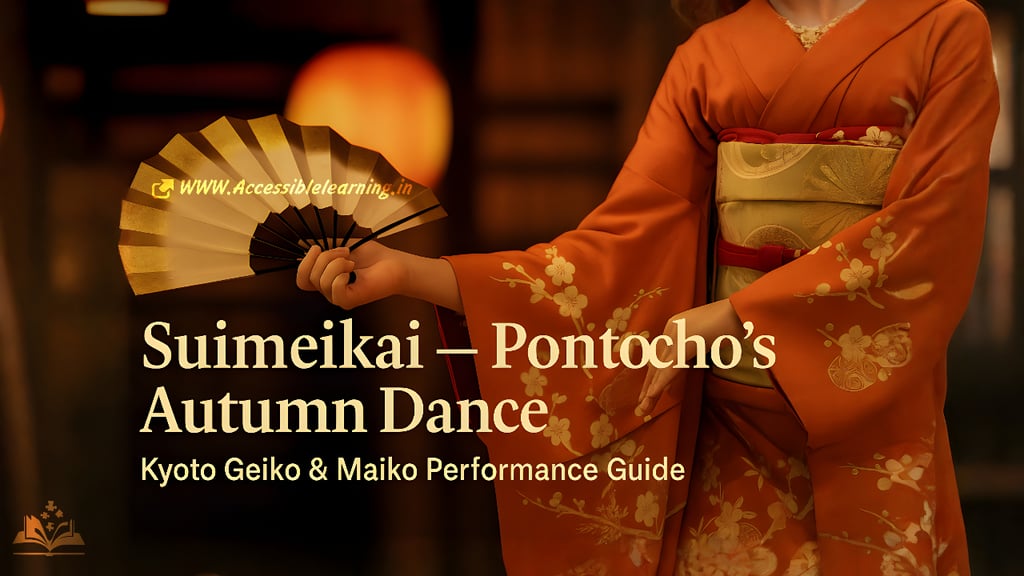
Suimeikai (Kyoto): A Complete Guide to Pontocho’s Autumn Geiko & Maiko Dance Performance
Discover Suimeikai, Kyoto’s autumn geiko and maiko dance performance in Pontocho. Learn its history, cultural significance, ticketing, etiquette, and travel tips.
EVENT/SPECIALTRAVEL LIFEJAPANCELEBRATION/FESTIVALS
Kim Shin
10/16/20253 min read


The Elegance of Kyoto’s Hanamachi
Kyoto is often called the cultural heart of Japan, and nowhere is its elegance more vividly expressed than in the seasonal dance performances of geiko (Kyoto’s geisha) and maiko (their apprentices). Among these, the Suimeikai stands out as an intimate autumn celebration in Pontocho, one of Kyoto’s five hanamachi (geisha districts).
Held annually at the Pontocho Kaburenjo Theatre, Suimeikai offers visitors a rare chance to witness the refinement of traditional Japanese dance, live music, and seasonal storytelling—a world normally reserved for ochaya (teahouse) patrons.
What is Suimeikai?
The word Suimeikai (水明会) translates to “Clear Water Gathering,” a poetic reference to the Kamogawa River, which flows beside the narrow alleys of Pontocho. This performance brings together the geiko and maiko of Pontocho to showcase classical Japanese dances accompanied by shamisen, flutes, drums, and traditional chanting.
Unlike the more widely known Kamogawa Odori (spring performance), Suimeikai is held in autumn, offering a different atmosphere—quieter, more intimate, and filled with seasonal elegance.
Historical Background
The origins of Suimeikai can be traced back to the early public dance performances of Kyoto’s hanamachi, where geiko and maiko shared their art with audiences beyond the private teahouse. Interrupted during wartime, these performances were later revived to preserve Kyoto’s intangible cultural heritage.
Today, Suimeikai is not only an art showcase but also a living bridge between past and present. Every gesture, costume, and melody reflects centuries of refinement, ensuring these traditions continue into the future.
When and Where is Suimeikai Held?
Season: Late October (dates vary yearly, usually over 3–4 days)
Venue: Pontocho Kaburenjo Theatre, a traditional playhouse located in the atmospheric Pontocho district, just west of the Kamogawa River.
Access: Easily reached from Kyoto’s Kawaramachi Station or Gion-Shijo Station.
Tip: Always check the official Pontocho Kaburenjo schedule for the exact dates before planning your visit.
What to Expect at the Performance
Attending Suimeikai is like stepping into a living artwork. Here’s what audiences usually experience:
Seasonal Dances—Each performance features several short pieces, some based on famous plays, others celebrating nature and seasonal themes.
Maiko & Geiko on Stage—Maiko, with their ornate hairpins and colorful kimono, bring youthful energy, while geiko embody elegance and mastery.
Live Music—The shamisen (Japanese lute), traditional flutes, and hand drums create an authentic soundscape.
Elaborate Costumes—Every kimono, fan, and prop reflects seasonal motifs and classical aesthetics.
With dozens of performers participating, each act offers a unique glimpse into Kyoto’s cultural soul.
Tickets & Seating
Price Range: Around ¥5,000–¥10,000, depending on seating category.
Seat Types: Reserved and non-reserved seating are usually available. Reserved seats offer better stage views.
Availability: As performances run only for a few days each year, tickets can sell out quickly.
🎟️ Recommendation: Purchase tickets in advance from official Pontocho Kaburenjo outlets or trusted travel agencies.
Etiquette for Visitors
Because Suimeikai is not just a performance but also a cultural tradition, etiquette is essential:
Arrive Early: Late arrivals may not be admitted once the performance starts.
Respect Silence: Applaud politely, but avoid loud noises or distractions.
Photography: In most cases, photography and video are not allowed during performances. Follow staff instructions.
Dress Respectfully: Smart-casual is fine, but modest clothing is preferred.
Accessibility & Language Notes
The historic Pontocho Kaburenjo Theatre has limited accessibility; inquire in advance if wheelchair support is needed.
Performances are non-verbal, focused on dance and music. Even without Japanese language skills, the visual storytelling is universally captivating.
Why Suimeikai Matters
Beyond entertainment, Suimeikai embodies Kyoto’s effort to preserve the artistry of its geiko and maiko for the next generation. Watching the performance is not just about seeing dance—it is about experiencing a cultural treasure shaped by discipline, community, and centuries of refinement.
For visitors, it is a chance to move beyond the tourist gaze and connect with the quiet dignity of Japan’s living traditions.
Tips for Visitors
Book Early: Tickets are limited and highly sought after.
Explore Pontocho: Arrive before your show to stroll its lantern-lit alleys.
Respect Privacy: Many ochaya are private establishments—avoid intrusive photography.
Combine with Autumn Sightseeing: Pair your Suimeikai visit with Kyoto’s autumn foliage at Kiyomizu-dera or Philosopher’s Path.
Related Events
Kamogawa Odori (Pontocho, Spring)—Larger, vibrant spring performance.
Gion Odori & Onshūkai (Other Hanamachi)—Autumn performances in Kyoto’s other geisha districts.
The Suimeikai is more than a seasonal event—it is a window into Kyoto’s cultural heart. By attending, you are not just watching a performance but sharing in a centuries-old tradition where every gesture, every note, and every smile carries the spirit of Kyoto’s hanamachi.
If you are visiting Kyoto in autumn, witnessing Suimeikai is an experience that will stay with you long after the curtain falls.
Subscribe to our newsletter
All © Copyright reserved by Accessible-Learning
| Terms & Conditions
Knowledge is power. Learn with Us. 📚


